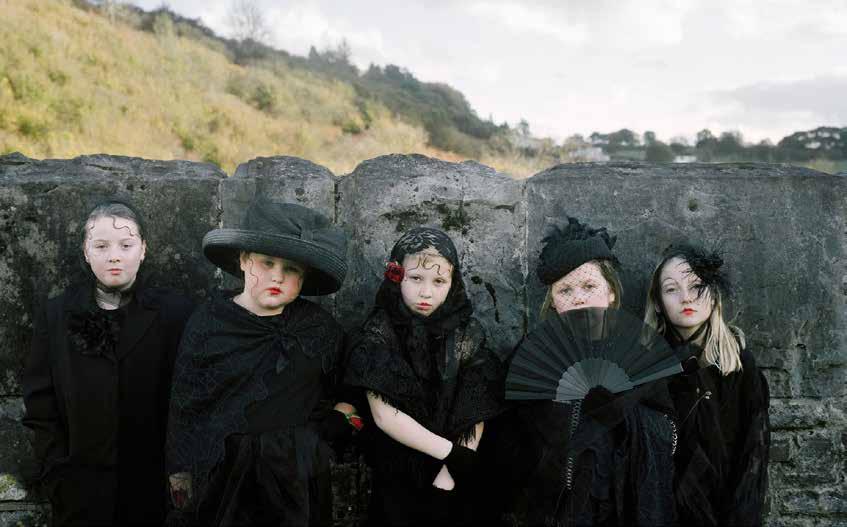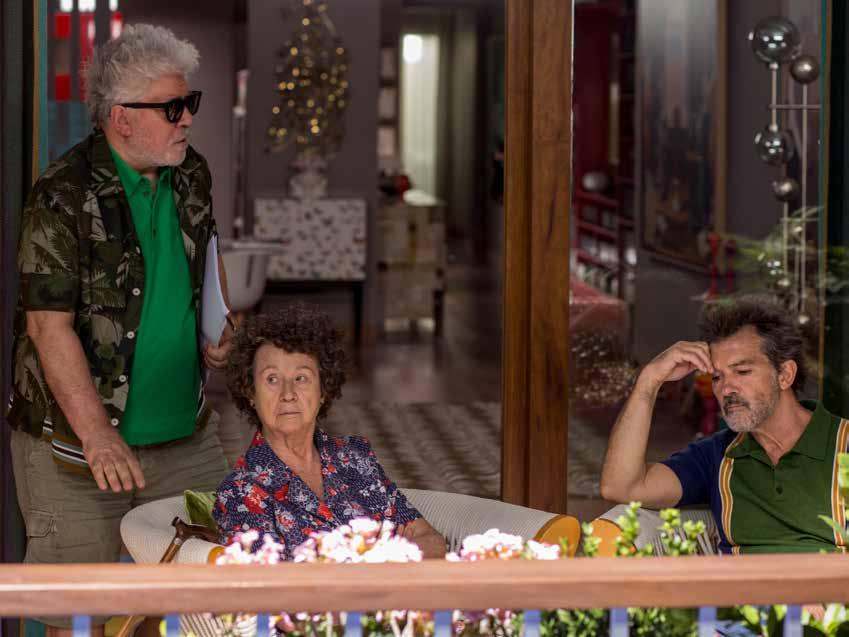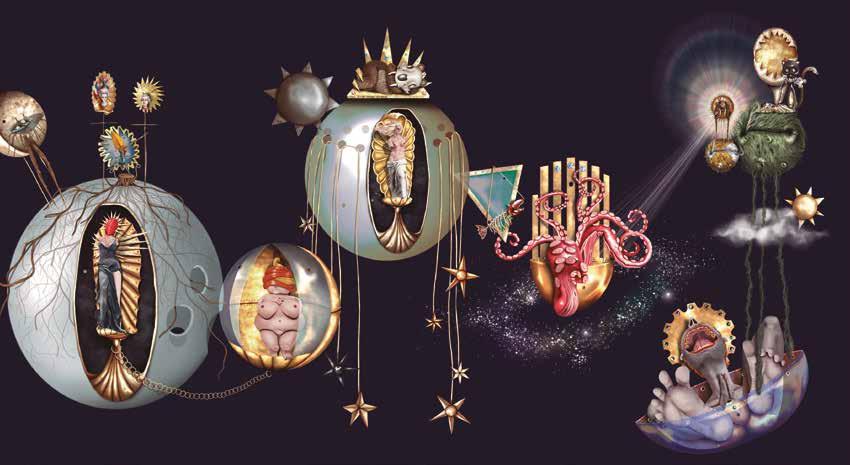
22 minute read
Saint Martins [ Moda
La magia de Central Saint Martins
The magic of Central Saint Martins / Die Magie von Central Saint Martins
Advertisement
R: JEN MUNAR
King’s Cross, en Londres, no es únicamente la entrada secreta al colegio de magia del universo Harry Potter. Si uno se fija bien, desde la plaza de esta popular área de la ciudad londinense, podrá ver un flujo constante de alumnos extremadamente bien vestidos, seguramente los mejor vestidos del mundo.
El motivo no es otro que la ubicación, desde 2011, de Central Saint Martins, la escuela de moda más famosa e influyente del mundo. En un entorno de alto nivel que requiere una alta implicación y gran competitividad no es de extrañar que de sus aulas hayan salido nombres tan importantes para la moda como Stella McCartney, Paul Smith o John Galliano. De hecho, muchos famosos de diferentes disciplinas se han interesado por asistir a sus clases, como Pierce Brosnan o el español y reciente nominado al Oscar, Antonio Banderas.
El diseñador mallorquín Sebastián Pons compartió aula con el recordado Alexander McQueen. Allí, entre sus pasillos nació la amistad de éste con Miguel Adrover que los llevó a lo más alto de la pasarela de Nueva York. También un ex alumno es el artista Carles Gispert.
Central Saint Martins College of Art and Design imparte gran variedad de disciplinas artísticas, no sólo moda, y de hecho tiene una aproximación liberal a la enseñanza. Muriel Pemberton, visionaria fundadora del departamento de moda, solía anunciar “Aprende las reglas, luego rómpelas”, una filosofía que a día de hoy todavía siguen a pies juntillas todos los diseñadores participantes en la Semana de la Moda de Londres, muchos de ellos exalumnos de esta escuela. Destacados diseñadores de moda Una academia que, si bien no tiene escobas voladoras o hechizos increíbles como Hogwarts, no está falta de una buena ración de magia.
King's Cross in London is not just the secret entrance to the magical school in the Harry Potter movies. If you find yourself in this popular part of London and look closely, you will see a constant flow of extremely well-dressed students, probably the best-dressed students in the world.
The reason is that ever since 2011 it has been home to Central Saint Martins, the
most famous and influential fashion school
in the world. In a high-level competitive environment that requires a high degree of involvement, it’s not surprising that names such as Stella McCartney, Paul Smith or John Galliano have emerged from its classrooms. In fact, many celebrities have also shown an interest in attending classes, such as Pierce Brosnan or the recent Spanish Oscar nominee, Antonio Banderas.
Mallorcan designer Sebastián Pons shared a classroom with the sadly departed Alexander McQueen. In its corridors, McQueen struck up a friendship with Miguel Adrover that would take them to the top of the New York fashion scene. Another former student is the artist Carles Gispert.
Central Saint Martins College of Art and Design teaches a wide variety of arts, not just fashion, and in fact has a very liberal approach to teaching. Muriel Pemberton, the visionary founder of the fashion department, used to say "learn the rules, then break them", a philosophy that all designers participating in London Fashion Week still follow today, many of them ex alumni of this school.
Featured fashion designers
A school which, although it doesn't have any flying brooms or incredible spells like Hogwarts, is not short of a good helping of magic.
King‘s Cross in London ist nicht nur der geheime Eingang zur magischen Schule in den Harry-Potter-Filmen. Wenn Sie sich in diesem beliebten Stadtteil von London aufhalten und genau hinschauen, werden Sie eine gleich bleibende Menge sehr gut angezogener Studenten sehen, vielleicht die am besten gekleideten Studenten weltweit. Der Grund: Seit 2011 ist dies die Heimat von Central Saint Martins, der berühmtesten und einflussreichsten Modeschule der Welt.
In dieser äußerst wettbewerbsorientierten Umgebung, in der man sich wirklich reinknien muss, ist es daher nicht verwunderlich, dass Größen wie Stella McCartney, Paul Smith oder John Galliano aus dieser Schule hervorgegangen sind. Tatsächlich haben viele Stars ein Interesse daran bekundet, hier auch einmal am Unterricht teilnehmen zu dürfen, wie zum Beispiel Pierce Brosnan oder der kürzlich für einen Oscar nominierte Antonio Banderas. Der mallorquinische Designer Sebastián Pons drückte gemeinsam mit dem leider verstorbenen Alexander McQueen die Schulbank. In den Gänge der Schule freundete sich McQueen mit Miguel Androver an und gemeinsam gelangten sie an die Spitze der New Yorker Modeszene. Ein weiterer ehemaliger Student ist der Künstler Carles Gispert.
Das Central Saint Martins College of Art und Design bietet Kurse in zahlreichen Kunstrichtungen, nicht nur in Mode, an und nimmt eine sehr liberale Herangehensweise an den Unterricht ein. Muriel Pemberton, Visionärin und Gründerin des Bereichs für Mode, pflegte zu sagen, dass man „die Regeln erlernen sollte, um sie dann zu brechen“, eine Philosophie, die alle Designer, die an der
London Fashion Week teilnehmen, immer noch befolgen - darunter viele ehemalige Schüler dieser Institution.
Teilnehmende ehemalige Absolventen
Eine Schule, die - auch wenn man hier nicht auf Besen fliegen oder Zaubersprüche erlernen kann wie in Hogwarts - dennoch von einer Portion Magie erfüllt ist.

25 años de diversión 25 years of fun / 25 Jahre Spaß
El 3 de diciembre de 1994 la primera PlayStation de la historia salió a la venta en Japón, y así lo haría en países del resto del mundo a lo largo del año siguiente. Desde el primer momento Sony, su creadora, se convirtió en uno de los grandes nombres de la industria gamer, compitiendo de tú a tú con otros gigantes como Nintendo.
Desde aquel 3 de diciembre han pasado por las manos de niños de todo el mundo títulos inolvidables como Crash Bandicoot , Grand Theft Auto , Resident Evil u otros más recientes como la saga Uncharted . Todos ellos, como no podía ser de otra forma, en formato CD-Rom, una de las grandes revoluciones que introdujo Sony desde sus inicios, en contraposición con los clásicos cartuchos.
Han pasado ya 25 años desde esos comienzos, y durante ellos cuatro generaciones de consolas, todas ellas con un éxito inmensurable y unas cifras de ventas estratosféricas. Ahora, y a modo de celebración del aniversario, nos encontramos a las puertas de una nueva generación, PlayStation 5, que tiene previsto su aterrizaje comercial durante el último trimestre del año.
Si su predecesora nos regaló gráficos de ensueño e incluso la realidad virtual, ¿qué podemos esperar de PlayStation 5? Como mínimo, podemos estar seguros de que nos deparará muchas más horas, días y años de diversión.
On December 3, 1994, the first ever PlayStation went on sale in Japan, as it would in other countries all over the world throughout the following year. From that moment onward, Sony, manufacturer of the PlayStation, became one of the big names in the gaming industry, competing head to head with other giants like Nintendo.
Ever since that December 3, unforgettable games have been played by kids all over the world, such as Crash Bandicoot, Grand Theft Auto and Resident Evil, or more recent ones like the Uncharted series. All of them in CD-Rom format, one of the major revolutions that Sony introduced from the beginning instead of the classic cartridges.
25 years have gone by since then, and seen four generations of consoles, all with immense success and stratospheric sales figures. To celebrate the anniversary, we will soon be seeing the new-generation PlayStation 5, scheduled to be in the shops in the last quarter of the year.
Its predecessor gave us amazing graphics and even virtual reality, so what can we expect from PlayStation 5? One thing we can be sure of, at the very least it will bring us many more hours, days and years of fun.
Am 3. Dezember 1994 kam die erste PlayStation überhaupt in Japan auf den Markt, andere Länder weltweit folgten im Lauf des folgenden Jahres. Von diesem Moment an wurde Sony, der Hersteller der PlayStation, zu einem der großen Namen in der Gaming-Branche und nahm den Konkurrenzkampf mit anderen Riesen wie Nintendo auf.
Seit diesem 3. Dezember wurden unvergessliche Spiele von Kindern auf der ganzen Welt gespielt, so zum Beispiel Crash Bandicoot, Grand Theft Auto und Resident Evil oder die neueren Titel der Uncharted-Reihe. Alle diese Titel gab es im CD-Rom-Format, wobei es sich um eine der revolutionären Neuerungen handelte, die Sony anstatt der klassischen Kassetten einführte.
Seitdem sind 25 Jahre vergangen, in denen vier Generationen von Konsolen aufeinander folgten, die alle äußerst erfolgreich waren und deren Umsatzzahlen in die Höhe schossen. Um diesen Geburtstag zu feiern, können wir bald die neue Generation der PlayStation 5 begrüßen, deren Markteinführung für das letzte Vierteljahr dieses Jahres geplant ist.
Ihr Vorgänger bescherte uns wunderbare Grafiken und sogar eine Virtual-Reality-Welt, was können wir also von der PlayStation 5 erwarten? Eines ist sicher: Es warten ganz bestimmt viele Stunden, Tage und Jahre voller Spaß auf uns.



Sinot Aqua, el barco propulsado por hidrogeno
The hydrogen-powered ship / Das Schiff mit Wasserstoffantrieb

R: Savina & Tristan
En el Monaco Yacht Show del pasado año, uno de los eventos náuticos más importantes del mundo, se presentó este espectacular yate propulsado por hidrogeno, el primero de su categoría 100% ecológico.
Muchos han sido los medios de comunicación que han afirmado que este yate pertenecía al multimillonario Bill Gates, cosa incierta ya que en la página web de Sinot, constructor de este barco lo desmienten.
Sinot Aqua, con un precio estimado de 644 millones de dólares y una longitud de 112 metros, está propulsado por hidrógeno licuado almacenado a temperaturas extremadamente bajas. Dispone de dos tanques aislados de 28 toneladas que mantienen el hidrógeno líquido a -253 ° C (-423.4 ° F) y ofrecen una autonomía de más de 6.500 km. Con cinco pisos acomoda a 14 invitados y 31 miembros de la tripulación y puede alcanzar una velocidad máxima de 17 nudos.
El hidrógeno se convierte en energía eléctrica alimentando dos motores de propulsión eléctrica y dos propulsores de proa para las maniobras de atraque.
También dispone de un amplio centro de salud en su interior, gimnasio, sala de hidromasaje, estudio de yoga, comedores y salas de entretenimiento para todos sus invitados.
Para disfrutar de las vistas del horizonte nada mejor que su observatorio de proa con una ventana gigante. Otras características del diseño incluyen: interiores con influencia japonesa, un helipuerto, donde un EVTOL impulsado también por hidrógeno puede aterrizar y despegar con los invitados, una mini cascada que deja caer el agua desde la piscina de la cubierta sobre escalones de piedra. Mientras tanto, el aspecto exterior del yate está inspirado en las olas del océano, con un casco esculpido cruzado por ventanas de vidrio. L ast year, at the Monaco Yacht Show, one of the most important nautical events in the world, this spectacular hydrogenpowered yacht was presented, the first in its category to be 100% ecological.
Many in the media have claimed that the yacht belongs to the billionaire Bill Gates, although this has already been refuted on the website of Sinot, the yacht builder.
Sinot Aqua was built at an estimated cost of 644 million dollars and has a length of 112 metres. It is powered by liquid hydrogen stored at extremely low temperatures. It has two 28-ton insulated tanks that keep the liquid hydrogen at a temperature of -253°C (-423.4°F) and has a range of more than 6,500km. With five floors, it can accommodate 14 guests and 31 crew members and can reach a maximum speed of 17 knots.
The hydrogen is converted into energy to power two electric engines and two bow thrusters for docking manoeuvres.
It also has a large health centre, gym, hydromassage room, yoga studio, dining rooms and entertainment rooms for all its guests.
And to enjoy the views of the horizon, nothing better than the bow observatory with its giant window. Other characteristics of the design include: interiors influenced by Japanese design, a helipad, where a VTOL aircraft also powered by hydrogen can take off and land with guests, plus a mini waterfall with water from the deck pool cascading over stone steps. The external appearance of the yacht is inspired by ocean waves with a sculpted hull with glass windows. L etztes Jahr wurde im Rahmen der Monaco Yacht Show, einer der wichtigsten Veranstaltungen im Nautikbereich weltweit, diese spektakuläre Yacht mit Wasserstoffantrieb vorgestellt, im Übrigen die erste ihrer Kategorie, die zu 100 % ökologisch ist. Viele Medienvertreter behaupteten, dass die Yacht dem Milliardär Bill Gates gehört, auch wenn dies bereits auf der Webseite von Sinot, dem Erbauer der Yacht, dementiert wurde.
Die Baukosten von Sinot Aqua werden auf 644 Millionen Dollar geschätzt und das Schiff ist 112 Meter lang. Es wird mit flüssigem Wasserstoff bei extrem niedrigen Temperaturen angetrieben. Die Yacht ist mit zwei isolierten 28-Tonnen-Tanks ausgestattet, die den flüssigen Wasserstoff auf einer Temperatur von -253 °C (-423,4 °F) halten, und hat eine Reichweite von 6.500 km.
Auf den fünf Stockwerken können 14 Gäste und 31 Crew-Mitglieder untergebracht werden und die maximale Geschwindigkeit beträgt 17 Knoten.
Der Wasserstoff wird in Energie umgewandelt, um zwei elektrische Motoren und zwei Bugstrahlruder für Anlegemanöver anzutreiben.
Außerdem gibt es ein großes Gesundheitszentrum, ein Fitnessstudio, einen Hydromassageraum, ein Yogastudio, Speiseund Entertainmentzimmer für alle Gäste.
Und um die Ausblicke auf den Horizont zu genießen, gibt es nichts Besseres als den Observationsraum am Bug mit dem riesigen Fenster. Andere Charakteristika des Designs sind wie folgt: Die Innenbereiche wurden durch den japanischen Stil inspiriert, es gibt ein Helipad, auf dem ein VTOL-Fahrzeug starten und landen kann, und einen Mini-Wasserfall, bei dem das Wasser vom Pool an Deck über steinerne Treppen nach unten fließt. Das Äußere der Yacht wurde inspiriert von den Wellen des Ozeans und weist einen geformten Rumpf mit Glasfenstern auf.
El auge del fútbol femenino en España
R:Jen Munar F:Jeffrey F Lin
La afirmación “el fútbol es para chicos” suena cada día un poco más anticuada si se tiene en cuenta el auge del fútbol femenino en España.
El fútbol no tiene género, y por eso ya nadie se extraña al ver a una niña jugando de portera, delantera o defensa en el patio del colegio. Aunque los cambios en este aspecto están siendo, como ocurre en todos los campos en los que se busca la igualdad de género, más lentos de lo que deberían, están ocurriendo.
El principal signo de ello no es otro que el aumento de telespectadores que han tenido competiciones como el último mundial, que ganó con soltura la selección de Estados Unidos. Son muchos los niños que ya tienen como ejemplo a mujeres futbolistas, que disfrutan imitando los goles de Jennifer Hermoso o aspiran a hacer paradas tan épicas como las de Sandra Paños. Hay ya, incluso, heroínas internacionales como la norteamericana Mia Hamm. El talento de muchas de nuestras futbolistas nos lleva a preguntarnos, si en el fútbol base los equipos son mixtos,
¿por qué se cambia de modelo a medida que la edad avanza? ¿No impide esa normativa que se dé el paso definitivo hacia la igualdad? Por el momento, continuamos avanzando, paso a paso, gol a gol, hacia esa ansiada igualdad que cada día se antoja más cercana.


The rise of women’s football in Spain Der Aufstieg des rauenfußballs in Spanien
“Football is for boys” sounds more and more outdated every day if you take into account the rise of women’s football in Spain. Football now has no gender, and that’s why nobody is surprised to see a girl playing as a goalkeeper, striker or defender in the school playground. As is always the case in which gender equality is the objective, the changes in football are occurring slower than they should, but they are occurring.
The main sign of this is none other than the increase in viewers watching tournaments such as the last World Cup, which the United States won with ease. There are many children who are already fans of women footballers and enjoy imitating the goals of Jennifer Hermoso or aspire to save shots just like Sandra Paños. There are already even some international heroines, like the American Mia Hamm.
The talent of many of our players leads us to ask ourselves, if teams are mixed in youth football, why do we change the model as people get older? Doesn’t that rule prevent the final step towards equality? For the moment, we continue to make progress, step by step, goal by goal, towards achieving the equality that seems closer every day.

„Fußball ist etwas für Jungen“ klingt jeden Tag mehr und mehr veraltet, wenn man den Aufstieg des Frauenfußballs in Spanien berücksichtigt. Fußball ist nun sozusagen geschlechtslos und deswegen ist auch niemand überrascht, wenn man ein Mädchen im Tor stehen sieht oder als Stürmer oder Verteidiger über den Platz rennen sieht. Wie immer, wenn es um die Gleichberechtigung der Geschlechter geht, findet ein Wandel im Fußball langsamer als von manchem oder mancher erhofft statt, aber er findet statt.
Das wichtigste Anzeichen für diese Entwicklung ist die wachsenden Zuschauerzahlen bei Turnieren wie der letzten Weltmeisterschaft, die die USA mit Leichtigkeit gewonnen haben. Viele Kinder sind bereits Fans von Fußballerinnen und imitieren gerne die Tore von Jennifer Hermoso oder möchten am liebsten die Bälle halten wie Sandra Paños. Daneben gibt es bereits sogar internationale Heldinnen wie die Amerikanerin Mia Hamm.
Das Talent von so vielen unserer Spielerinnen führt bei vielen Menschen zu folgender Frage: Wenn die Teams in der Jugend gemischt sind, warum ändern wir das in den höheren Altersklassen? Verhindert das nicht den letzten Schritt auf dem Weg zur Gleichberechtigung? Aktuell machen wir Fortschritte, Schritt für Schritt, Tor für Tor, hin zu der Gleichberechtigung, die jeden Tag näher zu rücken scheint.
Clementine Schneidermann Capturando el tiempo
Capturing the passage of time / Den Lauf der Zeit einfangen
F: R: JEN MUNAR CLEMENTINE SCHNEIDERMANN
Dos niñas en una calle vacía saliendo de plano, un festín solitario en otra calle desierta…
La fotografía de Clémentine Schneidermann (París, 1991) habla por sí misma si uno se limita a observar. Desde niños simulando ser adultos hasta imitadores de Elvis, todos ellos parecen guardar una historia propia en el fondo de sus miradas melancólicas. El paso del tiempo, ciudades desiertas, moda, color, emoción… son solo algunos de los términos que definen su arte.
Schneidermann, que empezó a fotografiar a los 17 años, trabaja una fotografía casi surrealista en la que los protagonistas, siempre misteriosos e interesantes, parecen estar intentando escapar de la cotidianidad, de las ataduras de la rutina y del día a día. En ella se puede ver, también, un claro interés por los efectos del paso del tiempo en la gente. Es por ello que los niños son prota

gonistas en muchas de sus imágenes: en ellos el paso del tiempo se ve mejor que en ningún otro lugar.
Las colecciones de Schneidermann se ha exhibido en lugares de prestigio como Tom Christoffersen Galleri, en Copenhague; Kickplate Gallery, en Reino Unido; Galerie Huit, en Francia, o en Tate Britain, en Londres. También ha trabajado en proyectos en España, Grecia, Alemania o Estados Unidos.
Two girls in an empty street leaving the scene, a solitary feast in another deserted street...
The photography of Clémentine Schneidermann (Paris, 1991) speaks for itself if one merely observes. From children pretending to be adults to Elvis impersonators, they all seem to hide a story of their own beneath their melancholic expressions. The passage of time, deserted cities, fashion, colour, emotion... these are just some of the terms that define her art.
Schneidermann took up photography at age 17, and takes almost surrealistic photographs in which the mysterious and interesting people she shoots seem to be trying to flee everyday life and escape the bonds of daily routine. Her photography also has a clear focus on the effects on people through the passage of time. That is why children appear in many of her photos. With children the passage of time can be seen even more clearly than with anyone else.

Schneidermann’s collections have been exhibited in prestigious venues such as the Tom Christoffersen Galleri in Copenhagen, Kickplate Gallery in the UUK, Galerie Huit in France, or the Tate Britain in London. She has also worked on projects in Spain, Greece, Germany and the United States.
Zwei Mädchen auf einer leeren Straße, die gerade gehen wollen, ein einsames Fest in einer anderen verlassenen Straße...
Die Fotografien von Clémentine Schneidermann (Paris, 1991) sprechen für sich selbst, wenn man nur hinsieht. Von Kindern, die vorgeben Erwachsene zu sein, bis hin zu Elvis-Imitatoren, scheinen sie alle eine ganz eigene Geschichte unter ihren melancholischen Gesichtsausdrücken zu verbergen. Der Lauf der Zeit, verlassene Städte, Mode, Farbe, Gefühle... Dies sind nur einige wenige der Begriffe, die ihre Kunst definieren.
Schneidermann begann im Alter von 17 Jahren mit dem Fotografieren und macht geradezu surrealistische Bilder, in denen die geheimnisvollen und interessanten Menschen, die ihr als Motive dienen, scheinbar dem Alltag entfliehen und aus den Zwängen der täglichen Routine ausbrechen wollen. Ihre Fotografie konzentriert sich ebenfalls auf die Auswirkungen der vergehenden Zeit auf die Menschen. Deswegen sieht man auf vielen ihrer Fotos auch Kinder. Anhand von Kindern kann man den Lauf der Zeit viel eindeutiger erkennen als durch andere Personen.
Schneidermanns Sammlungen wurden in renommierten Institutionen wie der Tom Christoffersen Galleri in Kopenhagen, der Kickplate Gallery in Großbritannien, der Galerie Huit in Frankreich oder der Tate Britain in London ausgestellt. Sie hat ebenfalls an Projekten in Spanien, Griechenland, Deutschland und den Vereinigten Staaten gearbeitet.
Los Milenials hemos sido una generación de copiones
R: Auba Riera F: Hannah Busing, Bruno-gomiero
Si bien es cierto que nos hemos pensado ser la generación más alternativa de la historia, en realidad palabras como ‘’hipster’’ no representan más que la bohem, una corriente melancólica que intenta copiar, con un toque digital, el estilo de los años de oro.
Siempre nos han dicho que no hemos inventado nada nuevo; Pero entonces, ¿Qué es lo que tanto nos diferencia?
Deberíamos empezar aclarando que los Baby Boomers son la generación nacida entre 1946 y 1964, por otro lado, los Milenials somos los nacidos entre entre 1981 y el 2000. Se dice de los Boomers que “hipotecaron su futuro” a cambio de acumular riqueza y que, por lo contrario, los Milenials estamos “destruyendo” el sistema industrial; ahorrando dinero, gastando menos y comiendo aguacates. Los Boomers son conocidos por su profesionalidad, su arraigamiento a la comodidad y privacidad y su poco afecto al mundo digital, mientras tanto nosotros, los Milenials, Twitteamos a la empresa que nos gusta, compartimos en Intagram los cereales de avena que pocos nos comemos y vivimos con el móvil pegado al bolsillo, así que si, somos dos generaciones separadas por las cookies. Las cartas, los e-mails formales y el pago en cash han evolucionado a mensajes de texto con ortografía que haría sangrar los ojos a cualquier dramaturgo, e-mails con emoticonos y un móvil que realiza pagos con simplemente rozar otro dispositivo.
Entonces, por mucho que permanezcan vuestras modas y nos atrape la bohem somos una generación de raros, zombis digitales, pero con carácter e inconformistas, un coctel de aguacate con gambas sin gluten que no ha pasado desapercibido, y puede ser, que esa fuera la intención.

Millennials have been known to be a generation of copycats
Although it is very true that we believe ourselves to be the most alternating generation in history, in reality, words like ‘’ hipster ‘’ only represent the bohemian, a melancholic trend that tries to copy the golden years with a digital touch.
We have always been told that we have not invented anything new; So, what is it that makes us so different?
We should start by clarifying that Baby Boomers are the generation born between 1946 and 1964. On the other hand, Millennials are those born between 1981 and 2000. Boomers are said to have “mortgaged their future” in exchange for accumulating wealth, whilst Millennials are “destroying” the industrial system, preferring to save money, spend less and eat avocados.
The Boomers are known for their professionalism, their comfort and privacy roots and their lack of affection for the digital world, whilst we, the Millennials, Tweet the company that we like, we share on Instagram the oat cereals that so few of us eat and we live with our mobile phones permanently glued to us. So yes, we are two generations separated by cookies. Letters, formal emails, and cash payments have evolved into badly spelt text messages that would make any playwright cringe, emails with emoticons, and a smart phone which makes payments by simply passing it over another electronic payment device.
So, as long as your style sense remains and we are captured by bohemia, we are a generation of weirdos, digital zombies, but with character and we are nonconformists, a gluten-free avocado cocktail with prawns that has not gone unnoticed, and maybe, from the very beginning, that was the intention.
Es stimmt zwar, dass wir uns für die alternativste Generation der Geschichte gehalten haben, aber in Wirklichkeit repräsentieren Worte wie “Hipster” nichts anderes als den Bohemismus, eine melancholische Strömung, die versucht, mit einem digitalen Touch den Stil der goldenen Jahre zu kopieren.
Man hat uns immer gesagt, dass wir nichts Neues erfunden haben; aber was unterscheidet uns dann so sehr? Wir sollten zunächst klarstellen, dass die Babyboomer die zwischen 1946 und 1964 geborene Generation sind, die Millenials hingegen die zwischen 1981 und 2000 geborene. Von den Boomern wird gesagt, dass sie ihre Zukunft “verpfändet” haben, um im Gegenzug Reichtum anzuhäufen, und dass die Millenials im Gegenteil das industrielle System “zerstören”; sie sparen Geld, geben weniger aus und essen Avocados.
Die Boomers sind bekannt für ihre Professionalität, ihre Verwurzelung in Komfort und Privatsphäre und ihre geringe Zuneigung für die digitale Welt, während wir, die Millenials, das Unternehmen, das wir mögen, twittern und bei Intagram den Haferbrei teilen, den nur wenige von uns essen und mit dem Handy in der Tasche leben, also ja, wir sind zwei Generationen, die durch cookies getrennt sind.
Briefe, formelle E-Mails und Barzahlungen haben sich zu Textnachrichten mit einer Rechtschreibung entwickelt, die jedem Dramatiker die Augen bluten lassen würde, zu E-Mails mit Emoticons und zu einem Mobiltelefon, das Zahlungen durch einfaches Berühren eines anderen Geräts vornimmt.
Also, so sehr Ihre Mode bleibt und wir uns in der Boheme verfangen, wir sind eine Generation von seltsamen, digitalen Zombies, aber mit Charakter und nonkonformistisch, ein Avocado-Cocktail mit glutenfreien Garnelen, der nicht unbemerkt geblieben ist, und vielleicht war das auch die Absicht.








